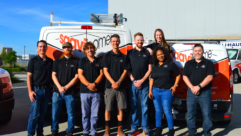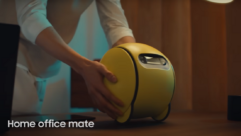SVC Podcast – Show Notes –
In this edition of the SVC Podcast, Contributing Editor Bennett Liles talks with John Downie, Vice President of Digital Experience at Advent about their AV system creation for Stanford University’s new Home of Champions. The facility highlights the achievements of student athletes and showcases the rich athletic tradition there. The centerpiece of the exhibit is a 60 foot wide PixelFLEX LED display that can be used in a number of ways to focus on the spirit and drive of Stanford’s legendary athletics programs.
Links of Interest:
- Advent’s story on the Stanford Home of Champions
- Stanford Home of Champions Youtube Video
- PixelFLEX, maker of the central LED video display
Download Podcast Here:
https://s3.amazonaws.com/nb-svc/public/public/194-1_Stanford_Home_of_Cha…
This is the SVC Podcast from Sound & Video Contractor Magazine with John Downie of Advent. Show notes and product links for this podcast and others are at svconline.com.
Stanford University’s athletics program is legendary, having won an astounding array of trophies but they wanted to go beyond the trophy cases and show much more. Advent was called in to outfit their new Home of Champions with a unique AV system. Advent Vice President of Digital Experience John Downie has the story on how it all came about. Coming up on the SVC Podcast.
John it’s a real treat to have you with us today from Advent to tell us the story of this amazing place that Stanford calls its new Home of Champions. Vice President of Digital Experience with Advent, you were right in the middle of this whole operation and it looks like your company was the right one to call for creating an absolutely magical environment.
Thank you very much. Good to be here, and thanks for inviting me on. So Advent has been around in its current form since 1999 when our current CEO one of the founders, John Robinson, bought the company. And we are effectively in the business of designing and creating experiences that move people. So we do that by realizing spaces and environments and weaving together kind of static exhibits with forms, with digital technology. But really just kind of creating moments of excitement and engagement with people to move them, to kind of have memorable brand experiences. We do this really through two main business verticals. One is for college and academic facilities in the U.S.; the academic and athletic side of those universities and institutions. And then secondly the pro sports teams. Those are really the two main verticals of operation that Advent currently are engaged in. [Timestamp: 1:56]
And I believe you also have the more broad title of Creative Technologist. Now, that’s really a very special-sounding job. What sort of experience and background does that require? That doesn’t sound like something you would see in the want ads.
[Laughs] Well, yeah. You hit on one of the challenges for us in the recruitment space. We talk about this role of the creative technologist because really a lot of what we do on the digital experience side – again that is a term that we apply a lot to what we do; the experience that something lends through a digital filter – is really taking all of the tenets and the ideas of existing AV and weaving that in with really high-end, cutting-edge, computer-based approaches to create these experiences. So we’re not just technologists. We’re not just coders and software engineers in the traditional sense. We create technologically-based experiences and that’s where the concept of a creative technologist comes from. We look for people with Swiss army knife backgrounds, for want of a better expression, who have got a lot of varied experience in a number of different disciplines. So my own discipline, for example – so my own background is I was a copywriter for a long time. I was a graphic designer for a long time. And when the Web started to become a thing I worked for a number of agencies in Europe. And so my background is graphic design; the semantics of traditional design combined with the sensibilities of a modern approach of digital backed up with a number of other experiences and the physical installation of high-end AV that allows us to create a lot of the high-end digital experiences that we’re able to do today. So for example, one of the projects that we recently completed is this very large searching projector – projection-mapping scenario onto a 40’ x 40’ model for the new L.A. Rams stadium that had been built in Inglewood, in Los Angeles, and that requires just a number of different kind of approaches from the software up to how are you going to fix these projectors into a building that is in an active seismic area? All of these disciplines have to be able to meet the challenges that are presented to us; feed into the concept of a creative technologist is. I gave you a very long answer there, but I hope that helps your audience to understand what we do in a little more detail. [Timestamp: 4:23]
Oh no, that’s fine. That probably requires some explanation. The specific project that I found so interesting is the new Stanford Home of Champions. This is a unique place and it obviously required a lot of imagination to come up with so how did Advent come into this? Had you worked with Stanford before or done previous athletic themed environments?
Firstly, thank you for your kind words on that project, which is really a flagship project for us. We have a very wide coverage nationally within the U.S. and the west coast is an area that we have worked in before. And when Stanford were looking to really reimagine what their hall of champions was going to be they really came to us to consult on what that could be. The program at Stanford, as we know, is incredibly storied. They have a very prestigious program. They wanted to tell the stories of the athletes and the programs that lead to the success of winning trophies and national championships. They have hundreds and hundreds of trophies that are available to them, but they didn’t want to just tell those individual stories of the trophies. They wanted to tell the back story, the wider story, of the program and its roots and the history and the stories of success that led to those achievements. So really they wanted an experience. They wanted a multi-stranded, deep experience that was rich in its storytelling, which is the area in which we excel. So they came to us within the context of knowing that some of our existing relationships our work there and yeah, we embarked on a multi-year program to realize what ended up becoming the Home of Champions. [Timestamp: 5:58]
And so how did you want to take them beyond a building full of trophy cases? I’m sure they have plenty of those and what you would normally think of finding in such a place is that’s what you’re going to see is just endless cases full of trophies but in this new Home of Champions you really don’t see that but you do see just about everything else.
You do, and thank you for picking up on that. That was a very meaningful approach was we didn’t want to just put lots of trophies on shelves. And that was actually a direction that came out from the process that we applied that we refer to as story mining, which is a trademark process that had been applied. That is an interview-based process where we interview varies key members of the programs or the brand or the organization that we’re working with. We really start to understand what the human stories are that sit underneath the individual successes, but are very easy to identify. What are the strands of humanity and story that really sit underneath each of those elements of the program that are more public? And as part of that process we really realized that it was about the athlete. It was about the coaching staff. It was the human story rather than the singular story of the trophy. The story of the trophy, the story of the individual win, it’s above that human story so we wanted to tell that story in the space. And I think you see that when you walk in. One of the first things you see are the faces of the individual athletes. We have a number of individual touchpoints within the space that allow visitors to really engage with individual stories from current athletes up to recognized alumni from a number of different athletic disciplines. So yeah, it’s really a program rooted in the human stories of the success of the program rather than the objectified results of that kind of success lends through trophies. [Timestamp: 7:42]
Well, I think the centerpiece of this whole thing is that huge video display that wraps around about half of the room. That’s a PixelFLEX system so how did you choose PixelFLEX for the display technology on this? I know they’re right there with you in Nashville so I would guess that you’ve done some things with them before as well.
We have. We’ve worked with PixelFLEX a few times and found them to be great folks to work with. They are in our backyard and it behoove us to work with someone who was accessible to us, who was close to us geographically for both testing and design purposes. But outside of that they have a great product and they’re a great bunch of guys and we value and leveraged their engineering teams to design this video board that, as you said, is really the centerpiece of the space, to some extent. I think there were a number of centerpieces, but from an AV perspective that really is the centerpiece. And the space really is multimodal, is something that we call it. It can be a reflective, quiet, almost museum-like space but it can also be a space for events. You can go from a very quiet, subtle and reflective atmosphere to something that is needing more energy. On game day when the team run through the space or after game day when they’ve had a great win, we wanted to amp up the space and the board allows us to do that. The board allows us to reflect each of those various modes so we can have text transition that’s a roll of honor of the inducted Hall of Fame athletes or we can run full-motion video on the board and turn up the sound system that is cleverly embedded in the board technology on either side and really create some adrenaline in the space as well. So that was the key part of the aesthetic design from the design team’s background as well that we were able to change the modality of the space. And working with PixelFLEX we were able to achieve that and create the visual look of the board that we were looking for. [Timestamp: 9:25]
I read that this space was originally just a basketball gym kind of surrounded by athletics offices but you took this place quite a way from there.
We did, yeah. So it’s always a fun thing to look back on what the space was and you’re right. It was maple-floored basketball court surrounded by offices and these glass walls at the very end. So it was a very high-vaulted ceiling, probably two-and-a-half to three stories at the apex of the roof. So when Stanford had identified this was the space that we wanted to move into yeah, we got to work designing a new space. And part of that was creating this mezzanine level; so splitting up that large vertical volume into actually two levels and that gave us the ability to create this wonderful staircase as a physical focal point to the space when you walk in. And also to create more floor space to house the individual exhibits. And then underneath that mezzanine we created this very quiet sacrosanct area almost where the Hall of Fame interactive is located that allows users to interact with a tabletop that tells the story of letter winners all the way through to those inducted Hall of Fame members. But yeah, it’s a complete transformation from what was there before. We’re very proud of the work and they’re very happy that Stanford were a great partner in that regard and we were able to express that collaborative vision. [Timestamp: 10:46]
And this huge video display largely dominates the space so how do you use it? What can be seen on it?
Going back to that part of it being multimodal, from a technology perspective the system runs on our proprietary interactive digital signage framework. One of the things that I think sets Advent apart is just our approach to digital and why we leverage third party applications for some of our more straightforward signage. Our internal capability as creative technologists allows us to create these wonderful, rich, immersive multithread experiences and part of the technical output of that is the platform that we’ve honed over many years and invested in significantly. So going back to that point of it being multimodal, we created a number of templates linked to our content management system that allow the athletic staff to manage a number of different types of content. So there are about 13 templates at the moment that are joined into a schedule so they can schedule content throughout the day or week or month ahead of time. And those templates range from a ticker board that runs through a number of names of those inducted Hall of Fame members through to coaching staff recognition and star athletes as well, recognition of those guys. And there are individual recruitment boards for each individual sport within the program as well that really pull out the highlighted statistics and new stories and current team rosters for each of the sports within Stanford’s athletics program. And they really form a canvas for the coaching staff to talk, walk a potential recruit through the success of a program, the history and heritage of a program. And then we have, like I said, we’ve got templates for a full-motion video to create more richness and energy within the space. And then free-form messaging that allows the coaching staff or the athletic staff to create messaging; maybe after game day congratulating various teams. When they’re welcoming groups of people to the space, maybe having a corporate event, the messaging channel allows them to welcome in that corporate visitor or that partner. So yeah, a number of different types of content are enabled through that board by our content management system. [Timestamp: 12:55]
Any athletics program is constantly evolving and renewing itself so you had to create a content management system that makes it easy for them to update and keep current.
Yeah, absolutely. That’s one of the key approaches that Advent takes is, as you said, the constant evolution of an athletics program – athletes in and out throughout, successes that need to be highlighted through the year and through the season, coaching staff movements, etc. And our framework is actually built with the simple tenet of allowing straightforward updates of any information above and beyond just a standard signage app. A lot of what we do is we allow the creation of dynamic, full-motion videos. We’ll take maybe a name that is held in the content management system and we’ll, in real time, create action effects almost like you’d see on ESPN and sports networks when they’re taking statistics and they’re creating live CGI around them. That’s what our platform does. The input to the platform from a data perspective is just a standard securitized web-based interface. I’ve actually been with the curation staff and we’ve been changing data on the boards through our phones and through our iPads. It’s as simple as that. Form an interface perspective there’s no special software needed. The interface is a standard web browser, so a lot of flexibility and power albeit delivered in a very simple, straightforward manner that allows a number of different team members to contribute to the evolving content story within the space and especially on that board. [Timestamp: 14:25]
Well, it’s certainly not just a space but as you said, an experience and a unique one. I don’t think I’ve seen anything like this before and it was fantastic hearing about what went into making it such a visual and engaging place. John Downie, Vice President of Digital Experience with Advent in Nashville and the new Stanford Home of Champions. Thanks so much for telling us about it.
Not at all. Thank you for allowing me to talk about this wonderful project. I appreciate it.
Enjoyed our conversation with John Downie of Advent. We’ve got some show notes and product links on the Sound & Video Contractor Magazine web site at svconline.com. Next week John will tell us about the technical side of the construction and how the AV system was made extra strong for San Francisco building codes. Stay tuned for all of that, next week.










